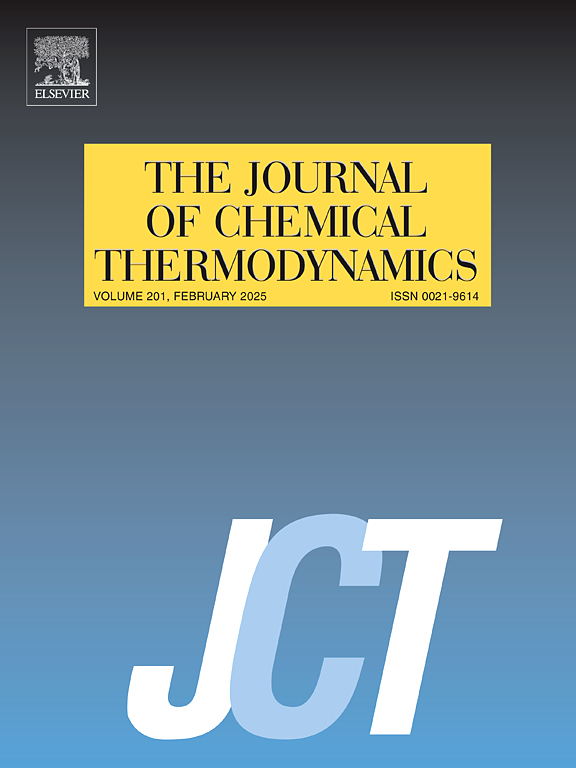N, N-二乙基乙醇胺 + 2-氨基-2-甲基-1-丙醇/哌嗪 + 水的三元水溶液在 T = (293.15 至 318.15) K 时的表面张力测量与建模
IF 2.2
3区 工程技术
Q3 CHEMISTRY, PHYSICAL
引用次数: 0
摘要
在(293.15 至 318.15)K 和 101 kPa 温度范围内测量了由 N,N-二乙基乙醇胺(DEEA)(1)、2-氨基-2-甲基-1-丙醇(AMP)或哌嗪(PZ)(2)和 H2O(3)组成的三元水性混合物的表面张力。研究了质量分数为 w1 = (0.20、0.25、0.30 和 0.35) 的 DEEA 和 w2 = (0.02 至 0.10) 的 AMP/PZ 体系。根据实验数据,得出了表面张力偏差(Δγ),在研究条件下,其值为负。利用基于 Scatchard 模型的多项式对 Δγ 值进行了拟合,平均绝对偏差 (AAD) < 0.099 mN∙m-1 ,平均相对偏差 (ARD) < 0.31 %。此外,还使用傅里旺(FLW)模型和扩展威尔逊模型对表面张力值进行了拟合。结果表明,这两种模型都能很好地将表面张力与温度和成分的函数联系起来。FLW 模型的拟合结果更好,AAD 分别小于 0.24 mN∙m-1 和 ARD 小于 0.68 %。此外,还根据表面张力的温度依赖性估算了表面焓(Hγ)和表面熵(Sγ)。本文章由计算机程序翻译,如有差异,请以英文原文为准。
Surface tension measurement and modeling for ternary aqueous solutions of N, N-diethylethanolamine + 2-amino-2-methyl-1-propanol/piperazine + water at T = (293.15 to 318.15) K
The surface tensions of ternary aqueous mixtures composed of N, N-diethylethanolamine (DEEA) (1), 2-amino-2-methyl-1-propanol (AMP) or piperazine (PZ) (2) and H2O (3) was measured at temperatures ranging from (293.15 to 318.15) K and 101 kPa. The systems with mass fractions of w1 = (0.20, 0.25, 0.30 and 0.35) DEEA, and w2 = (0.02 to 0.10) AMP/PZ were investigated. According to the experimental data, the surface tension deviation (Δγ) was obtained and the values were negative under the studied condition. Δγ values were fitted using a polynomial based on the Scatchard model with the average absolute deviation (AAD) < 0.099 mN∙m−1 and the average relative deviations (ARD) < 0.31 %. Moreover, the surface tension values were fitted using Fu-Li-Wang (FLW) and the extended Wilson models. The results revealed that both models can well correlate the surface tension as a function of temperature and composition. FLW model exhibited better fitting results with smaller AAD of less than 0.24 mN∙m−1 and ARD less than 0.68 %, respectively. Additionally, surface enthalpy (Hγ) and surface entropy (Sγ) were estimated based on the temperature dependence of surface tension.
求助全文
通过发布文献求助,成功后即可免费获取论文全文。
去求助
来源期刊

Journal of Chemical Thermodynamics
工程技术-热力学
CiteScore
5.60
自引率
15.40%
发文量
199
审稿时长
79 days
期刊介绍:
The Journal of Chemical Thermodynamics exists primarily for dissemination of significant new knowledge in experimental equilibrium thermodynamics and transport properties of chemical systems. The defining attributes of The Journal are the quality and relevance of the papers published.
The Journal publishes work relating to gases, liquids, solids, polymers, mixtures, solutions and interfaces. Studies on systems with variability, such as biological or bio-based materials, gas hydrates, among others, will also be considered provided these are well characterized and reproducible where possible. Experimental methods should be described in sufficient detail to allow critical assessment of the accuracy claimed.
Authors are encouraged to provide physical or chemical interpretations of the results. Articles can contain modelling sections providing representations of data or molecular insights into the properties or transformations studied. Theoretical papers on chemical thermodynamics using molecular theory or modelling are also considered.
The Journal welcomes review articles in the field of chemical thermodynamics but prospective authors should first consult one of the Editors concerning the suitability of the proposed review.
Contributions of a routine nature or reporting on uncharacterised materials are not accepted.
 求助内容:
求助内容: 应助结果提醒方式:
应助结果提醒方式:


